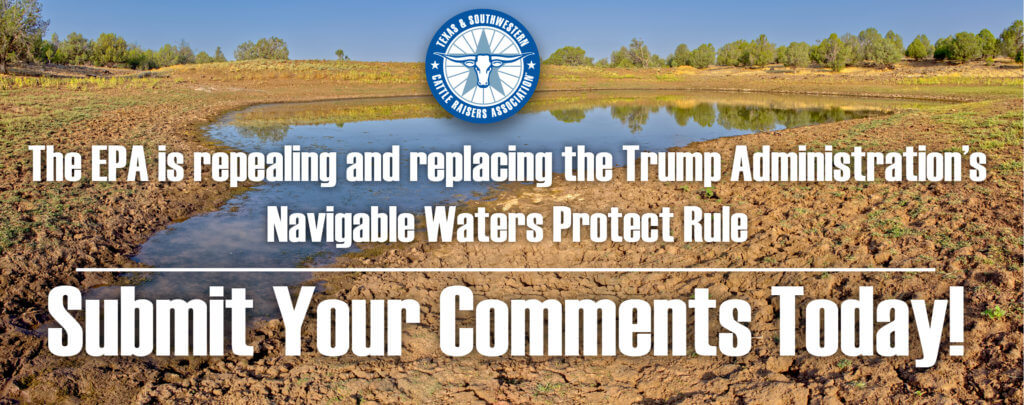
Your stock tank isn’t a Water of the United States, and it shouldn’t be federally regulated!
After years of fighting an overreaching WOTUS rule, we were finally able to secure a clear, common-sense definition of what constitutes a federally regulated water feature. It didn’t include dry creek beds, stock ponds and puddles. Now, however, we’re at risk of losing those critical achievements as the EPA and Army Corps of Engineers prepare to replace the Navigable Waters Protection Rule.
We must once again fight to ensure the federal government does not succeed in another brazen land grab at expense of cattle producers and landowners.
The agencies are accepting comments until Feb. 7.
Please tell them how you feel! It’s easy, just scroll down. We’ve prepared draft comments that you can use or modify to your liking, and detailed instructions on how to submit your comments.
Thank you for helping fend off yet another challenge to our private property rights!
Month, Day Submitted, 2022 Hon. Michael Regan Administrator U.S. Environmental Protection Agency 1200 Pennsylvania Avenue, NW Washington, DC 20460 Hon. Michael Connor Assistant Secretary U.S. Army Corps of Engineers 441 G Street, NW Washington, DC 20314 Docket No. EPA-HQ-OW-2021-0602-0001 Submitted via Regulations.gov Replace with name Comments on the Environmental Protection Agency and Army Corp of Engineers’ Proposed Rule Defining the Scope of Waters Protected Under the Clean Water Act To Whom it May Concern: I appreciate the opportunity to submit comments on the Environmental Protection Agency’s (EPA) and U.S. Army Corp of Engineers’ (Army Corps) (the agencies) proposed revisions to the Waters of the United States (WOTUS) defining the scope of waters protected under the Clean Water Act (CWA). Cattle producers and landowners, such as I, need a clear definition of WOTUS that will allow us to assess whether we have federally jurisdictional waters on our property without spending limited resources to hire outside consultants and hydrologists. Many of our operations are multi-generational, having dealt with every iteration of CWA jurisdiction since its passage in 1972. After enduring almost 50 years of jurisdictional battles, we need clarity to best comply with CWA, so we may run our businesses efficiently and free of bureaucratic restrictions. Unfortunately, clarity has yet to be achieved through this proposed rule. We are once again faced with a broad definition that does nothing to improve our ability to determine what qualifies as a “water of the United States.” A very important provision for ranchers and landowners omitted from the new WOTUS definition is the relinquishment of jurisdiction over certain ephemeral tributaries and intermittent streams. Returning the flow path of these occasional, small channels and streams into the regulatory structure of the Clean Water Act (CWA) is a major violation of private property rights by the agencies. To make matters even less clear, this new definition allows the agencies to blend the overly broad opinions of Supreme Court Justices Scalia and Kennedy in the Rapanos case to determine if a puddle or stream made by a recent rain is a significant nexus and thus federally regulated. This case-by-case process will only lead to further confusion for landowners and more bureaucratic red tape. I am also extremely concerned to see this definition retract valuable agriculture exemptions for stock ponds, playa lakes and other agricultural water features. The change will further burden ranchers and landowners without improving water safety or environmental quality. With this definition in place, countless projects that would improve water quality and availability will be blocked by an overreaching WOTUS rule. In many states, such as Texas, we rely heavily on groundwater which we privately own as the landowner. However, this new definition fails to explicitly exclude federal jurisdiction over groundwater, which along with the inclusion of jurisdiction over adjacent wetlands, could infringe upon our groundwater ownership rights. This is very concerning and is a notable departure from features that have been historically viewed as beyond the scope of CWA jurisdiction. Without this exclusion, many of us are wary that the agencies will use the overly broad WOTUS definition to federally regulate groundwater, which should not be a medium subject to federal jurisdiction but rather an intrastate resource left to the states to manage, either alone or regionally. As a rancher and landowner who will be impacted by this new definition, I respectfully request additional revisions be made to bring clarity for landowners, reimplement crucial agricultural exemptions, explicitly exclude federal jurisdiction over groundwater and exclude certain ephemeral tributaries and intermittent streams from jurisdiction. These changes will allow cattle producers and landowners to confidently implement conservation management practices that benefit all of our natural resources without fear of violating obscure governmental regulations. Thank you for the opportunity to submit comments on the revised definition of WOTUS. Sincerely, Replace with your name
Instructions
- Copy and paste the above text into your word processor (i.e. Microsoft Word).
- Helpful Hint: When you paste the text into your document, right click and paste using the “Keep Text Only” button.
- Fill in the highlighed areas with the date, and your name, and make any other adjustments you would like to personalize the comments.
- Save the document as “Comments on Revised Definition of WOTUS EPA-HQ-OW-2021-0602-0001”
- Go to: https://www.regulations.gov/commenton/EPA-HQ-OW-2021-0602-0001
- Upload your document (.doc, .pdf, .wpd and several other file formats are acceptable)
- Check the box if you want to receive an email confirmation
- Select “Invidual” and fill out the required contact information
- Check the “I am not a robot” box
- Click Submit!
- Share your comments with your friends, so they can submit some too!
